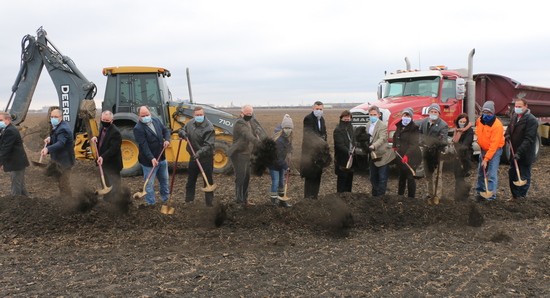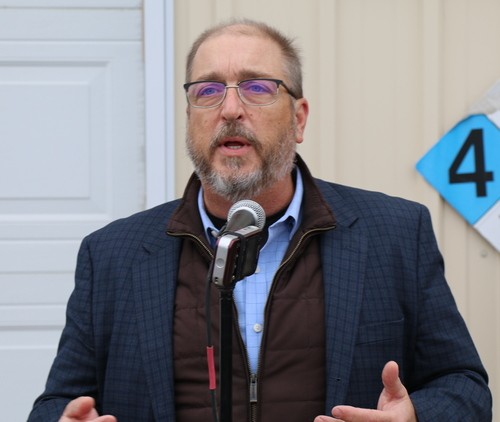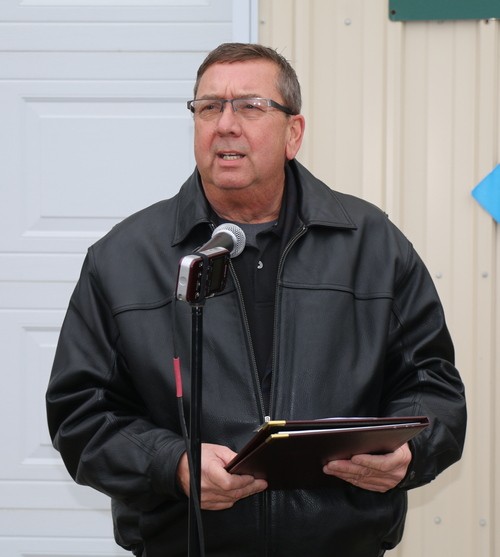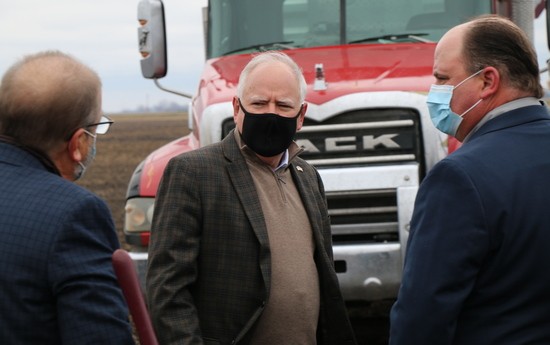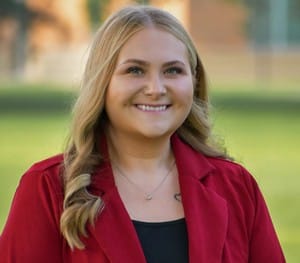[yotuwp type=”videos” id=”NbYRN1vLsP4″ ]
Another major milestone for the Ag Innovation Campus was reached on Wednesday when the facility’s groundbreaking ceremony was held. The ceremony was attended by local and state leaders, including the Crookston City Council members, Crookston Housing and Economic Development Authority Board, Senator Mark Johnson, Representative Deb Kiel, and Governor Tim Walz.
Tom Slunecka, the Executive Director/CEO of the Minnesota Research & Promotion Council and Minnesota Soybean Growers Association, said the Ag Innovation Campus fills the gap between ideas and brings new products to commercialization. “What we found is there is really what we call – the valley of death. That’s the place between benchtop idea or new genetics and commercialization. In between is a very, very expensive process that many great ideas can’t make it through that valley. They end up falling apart, or can’t find funding, or most importantly, they can’t find a place to be tested at a large enough scale to prove that they’re viable. That’s really what this project is all about. This project is about how do we create enough feedstocks consistently day in and day out so that new developments can be seen to fruition and make it to our farm gates and consumers all across the nation.”
The northwest Minnesota region centered around Crookston is the largest soybean producer in the United States. Slunecka said it made it an ideal location for a first of its kind facility like the Ag Innovation Campus. “There isn’t a facility like this anywhere in the world,” said Slunecka. “This is going to be the first of its kind where it is crushing soybeans. It will, at some point in time, be able to crush any oilseed crops as well. Anything from the new cover crops we’re trying to develop, to sunflowers, to canola, any type of product like that will be able to be processed through this facility. We are going to start with soybeans because this is soybean country. From an acres standpoint, quite honestly, this is the biggest soybean production area in the United States. So, where else would we build a center like this then Crookston.”
Jim Lambert, project manager, said the campus will have three distinct features – the crush facility, the agricultural business incubator, and an education and office center. “When you look at the Ag Innovation Campus, I look at it as three parts,” said Lambert. “Tom talked about a small crush which will be the heart of the Ag Innovation Campus. In that section, we’ll have three lines for crushing soybeans or any other oil crop you may want to bring in eventually. We will have the ability to do research trials in that particular unit. Things like high-oleic soybeans, non-GMO soybeans, organic soybeans, any kind of soybean you can think of. Also, when seed companies have trials, they want to figure out what their meal looks like or what the soybean oil will look like. They’ll be able to come, and we’ll be able to produce enough so they can actually go out and do commercial trials.”
More than 80 farms across the region will have a positive value-added impact from the facility that will crush approximately 2.5 million bushels of soybeans a year, explained Lambert. “The small crush will be doing about 8,000 bushels of soybeans a day, which is 8-10 truckloads, which will be about 2.5 million bushels over the course of a year,” said Lambert. “As far as soybean crushes go, that’s a pretty small number, but for us, that’s a pretty big number. Those 2.5 million bushels translate to about 61,000 acres of soybeans, which will impact between 80-100 farms in northwest Minnesota. The byproduct of that will be about 2.5 million gallons of soybean oil, which can then be converted into high-value biodiesel. We’ll also be producing about 64,000 tons of soybean meal, which in the eleven-county area of northwest Minnesota, the demand for soybean meal is about 184,000 tons, so we can only meet about one-third of the need in northwest Minnesota.”
The campus will also house companies looking to grow and develop commercially viable products said, Lambert. “The second business area we look at is the industrial innovation bays,” said Lambert. “Right now, we’re scheduled to have ten of those. That will allow some of those companies to prove their ideas, test their processes, and develop commercially viable products. There will be several different companies, and we can move the bays to make them smaller or larger, depending on what they need. There will be a lot of synergies with other companies while they’re in there. They’ll be able to talk to other entrepreneurs in other stages of development. We’ll have research teams available, technology teams, from AURI. It’s really more of an agricultural business incubator.”
Governor Tim Walz called the Ag Innovation Campus an investment by the state, by Crookston, and by local producers to create something unlike anything else in the world. “It’s a great thing for Crookston and the regional economy,” said Walz. “And it’s a great thing for Minnesota. Minnesota Soybean Growers – always been innovators whether it’s increasing yields or opening up new markets and new uses of soybeans. This innovation center, unlike anything else in the world, can focus on that. We’re investing as a state in this, but so are the producers investing in this. And, so is the City of Crookston, so it’s a great day.”
Walz said he’d love to see the next great food or fiber producer get their start in Crookston because of the research and exploration of new soybean markets that will take place at the campus. “We don’t know what’s out there yet, but I keep saying this – we’re leading,” said Walz. “We stand firm on being ones who are reducing carbon emissions. Biodiesel is a huge advantage. We need to expand its usage. We’re trying to do that in Minnesota. But I think there is things out there yet that we don’t know. There are products that can be made out of this. It’s food; its fuel, it’s fiber. We don’t know if it’s pharmaceuticals or if there are other things out there. But having something like this, focused on this research, on opening new markets and the incubator you’re talking about. What we’d really love is the next great food-producing or fiber-producing company to get started in a garage here at this and then move out and create new jobs.”
Ag Innovation Campus Board Chair Mike Skaug also thanked the state and local officials in attendance, including the Minnesota Department of Agriculture represented by Deputy Commissioner Andrea Vaubel, the City of Crookston, Polk County, and the Crookston Housing and Economic Development Authority. “When we launched this thing, I just can’t get over how excited we were once we got the grant dollars from the State of Minnesota,” said Skaug. “I do want to acknowledge the City of Crookston, the Commissioners from Polk County, and everyone at CHEDA. Craig Hoiseth has been a great asset to us working with him and the City of Crookston, and we’re very happy about that.”

